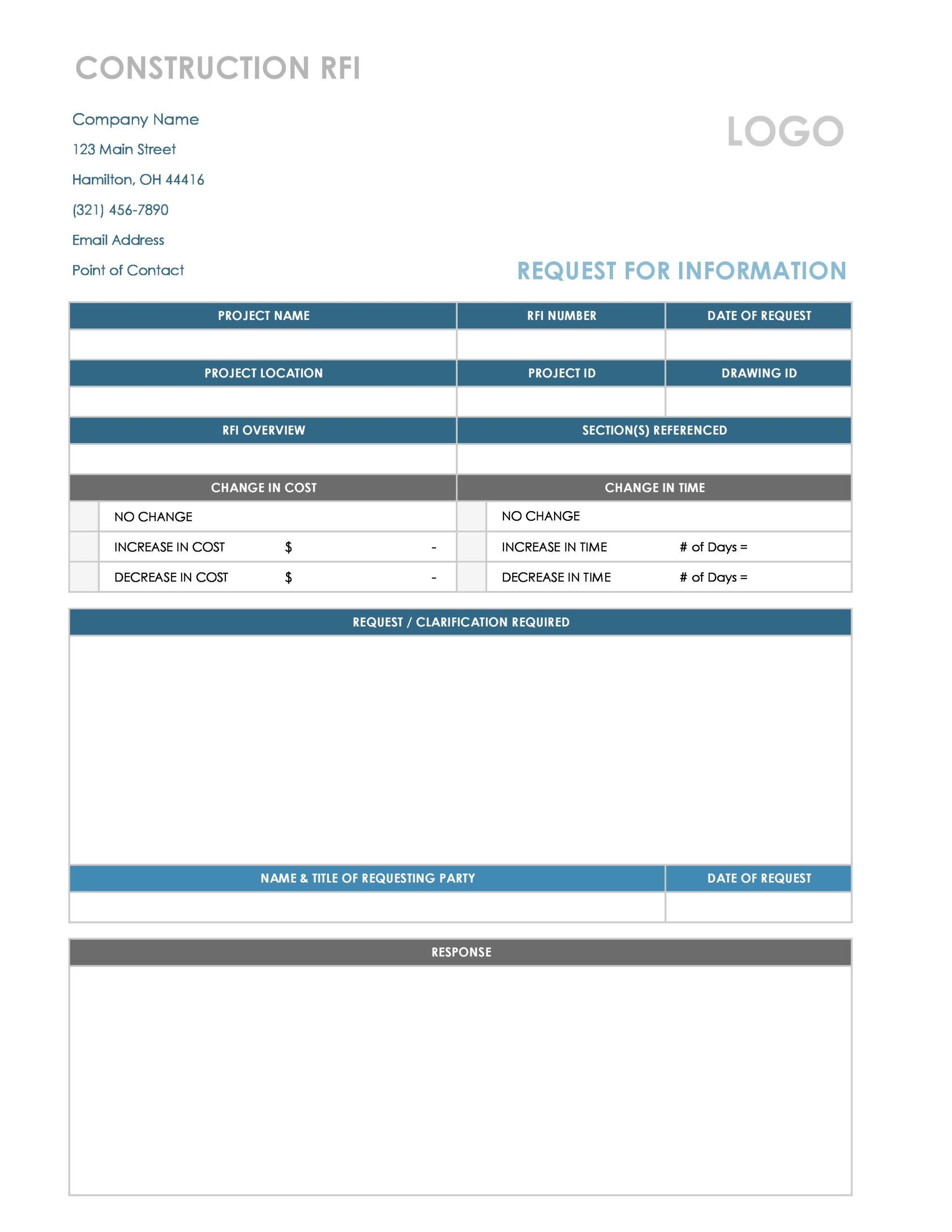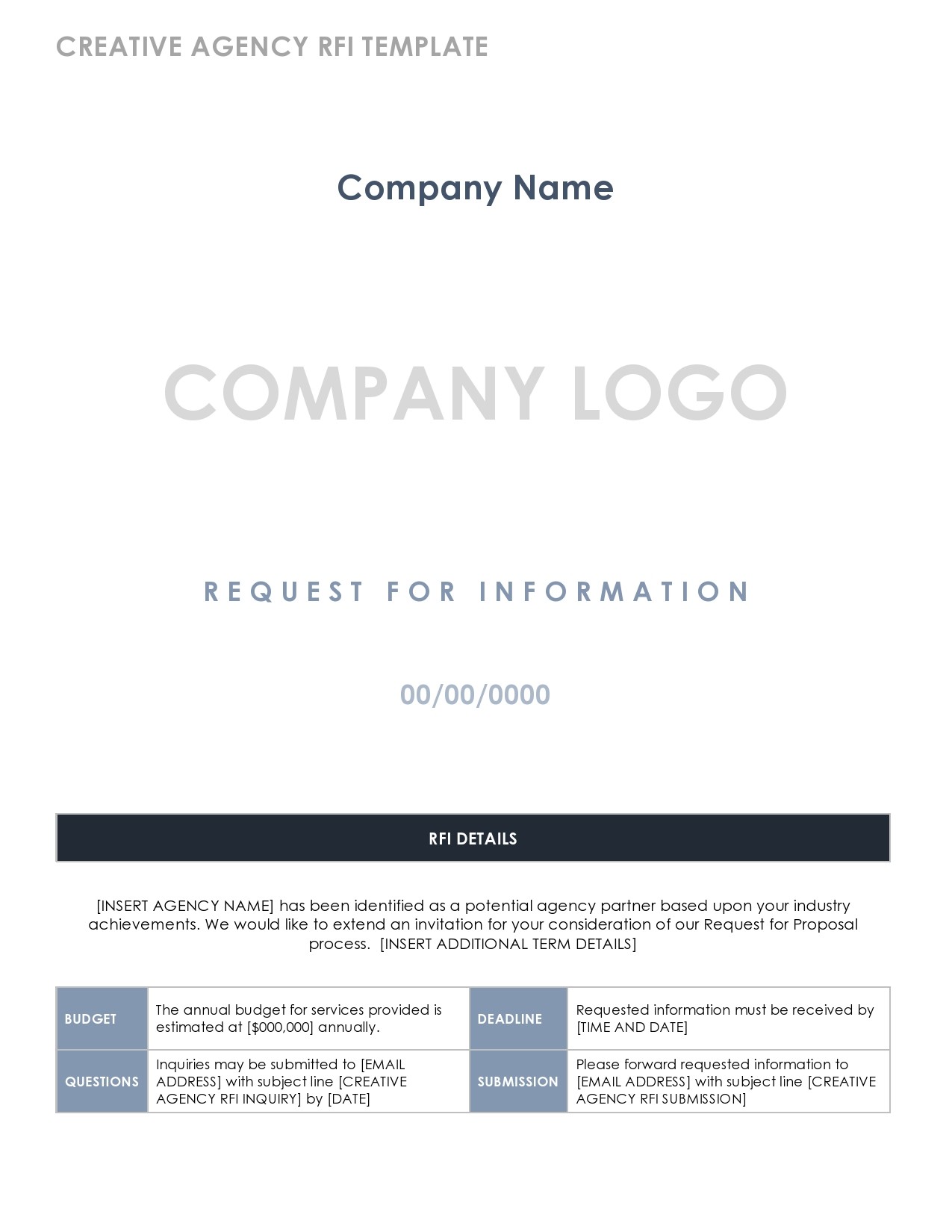It’s a part of every business process to request for the information about a service or product from an agency or vendor or supplier. Before making a deal, it’s always advisable to collect the information in a formal documented way. For this, you can use a request for information template. This helps define or improve your scope of work for a request for proposal (RFP).
Table of Contents
Request For Information Templates
What is RFI format?
A request for information template is a document that asks suppliers for general information regarding the solutions they can provide to make your comparison of vendors easier. The process involved in an RFI provides you with comparable and useful information from vendors.
This may lead to your business getting better equipped to understand the available solutions and consequently, make informed decisions on how to move forward. Here are some situations when you should use an RFI template:
- For a one-time procurement project
Requesting for information is often the first step in the procurement process. You can use this document when you have a challenge to overcome. The problem is that you might not know the available solutions or even if you will make the purchase.
This means you want to know your options before deciding to proceed. As soon as you have gathered responses, you can use this information to make a request for a proposal. This document contains more specific questions and a hint about your intention to purchase. - For recurring procurement projects
One purpose of this document is to gather vendor information. As a business owner, you can take advantage of this by using templates to create vendor profiles for recurring procurement projects.
For instance, this document can help your procurement teams quickly search records and come up with a shortlist for their RFP in no time. Moreover, because vendor profiles contain all of the information, the RFP can be more specific and much shorter to your current business needs.
RFI Templates
When do you need a request for information template?
Sending out RFI formats to your suppliers provides clear communication to them in defining the scope of the document, the purpose, your requirements, and your expectations in terms of their responses.
A typical RFI document may include a number of questions that vendors need to answer along with information about your business, your procurement processes, and your project needs. The primary goal of this document is to gather the information that you will use in the next step of the decision-making process.
Since one of the objectives of a request for information template is the creation of a shortlist of potential suppliers, having detailed written information from each potential vendor will hasten the process of narrowing down your choices. That way, you can choose appropriate suppliers efficiently.
This document can also provide you with a standardized process of collecting information that shows suppliers that you’re acting both competitively and fairly as you make comparisons. The information to include in this document depends on its intent. Here are some common things you will find in an RFI:
- An introduction with an explanation of the document’s purpose.
- A description of your process for reviewing supplier responses and giving RFPs.
- The rules for how suppliers must respond to your RFI.
- The requirements the suppliers should meet.
Your document must include details for whatever you need from suppliers. This may include products, delivery methods, pricing, and other relevant information. You may also add a request for acknowledgment from the supplier that they have received the document and a confidentiality clause for them to agree to.
To make things easier for you, consider downloading a pre-formatted template. This helps you save time while standardizing your process. You can also edit templates easily according to your own needs.
RFI Formats
What questions should I ask an RFI?
Since you must ask a number of specific questions in your RFI formats, you should know which questions to ask depending on the situation. For instance, if you need more information about a certain system, your RFI template may include these questions:
- Does the system permit safe access for:
Families
People with disabilities
Agency administrative staff members
Direct support professionals
Consultants
State staff
Analysts - Is the system being currently utilized by:
Families
People with disabilities
Agency administrative staff members
Direct support professionals
Consultants
State staff
Analysts - Is the system completely web-based to allow access from various locations?
- Can the system provide notifications in real-time through email or text messages?
- Does the system comply fully with the following HIPAA requirements:
The creation of data is both time-stamped and tracked.
Access data is both time-stamped and tracked.
Any changes or deletions are both stored and tracked.
Allow for secure email-type communication that’s compliant with HIPAA standards.
All users provide their fingerprints or other unique logins for secure identification.
All activity, including actions, users, and IP addresses are completely tracked. - Can the system get implemented immediately?
- Can the system effectively interact with other systems?
- Does the system keep track of:
Incident reports including follow-ups
Demographics
Progress notes from direct support professionals and other members of the team
Individual Service Plans
Health Information
Behavioral plans and data
Progress towards goals
Service Authorizations
Billing Data
Attendance
Staff Training
Personal Finances
Medication Administration - Are the available training materials aimed specifically at various staff groups?
- Do the available training materials come in different languages?
- Are in-person, hands-on, and on-site training available?
- Does the system itself work in different languages?
- Do you offer live assistance 24/7?
- Can you share data securely as required by HIPAA standards?
- Does the system encourage best practices and collaboration nationally or within the agency?
RFI Documents
How do you write a request for information?
You can use RFI formats to ask several suppliers for specific information to help you make a more informed decision. This is why it’s important to ask the right questions from the start. Here are some tips for making an effective RFI document:
- Start from the highest level of information
This is the first step in the process where you can liken the request for information template to sending your prospective suppliers an introductory message. For you, it’s like testing the waters where there is no need for promises yet. For this step, you should:
Identify your goals and any possible challenges
Tell the supplier who you are, what your goals are, and the potential challenges you may confront. Don’t delve into specifics yet but make sure that the information you provide gives your potential suppliers a chance to decide whether they will deal with you further.
Pay attention to perspectives, not just their capabilities
The response you get from your request for information form from potential suppliers might show you the capabilities and expertise they possess, but remember that things might change. This is why you need to focus more on their perspectives. - Use the proper format
Choosing a proper template can get you the right information from the start. If you don’t have one now, you can also create one. An easy way to do this is to use the software application you’re comfortable with. This saves you resources and time while allowing you to modify the template to suit your requirements. - State your questions concisely and clearly
Remember that you’re asking for information to help you make decisions. As such, potential suppliers can’t give you an answer if you don’t ask them the right questions. Here are some tips for this step:
Keep your questions simple
You don’t need to ask complex questions. Try asking one question at a time. Also, Don’t use jargon so that the suppliers can understand your questions clearly.
Maintain professionalism
Remember to show respect to your potential suppliers. Research on them before writing down your questions. Also, avoid asking questions where you can easily find the answers online.
Define an appropriate response
Don’t keep your potential suppliers guessing – just tell them. This is especially true when you have complicated issues.
Supply enough information
The clearer you make yourself, the more likely you will get an accurate and timely response from potential suppliers. - Make things easy to compare
One of the goals of this document is to secure enough information from suppliers who you might deal with for the first time. Based on the responses you get, you can make the decision on whether you need to make an RDF or RFQ. - Show consideration
You won’t lose anything if you develop a sustainable and positive relationship with several suppliers. Showing respect and consideration by appreciating the effort and time from the recipients of this document can be a great start. Here are some ways to do this:
Limit your questions
This document should provide you with just enough essential information that you need to move on to the next step. Make sure that the questions you ask are both relevant and necessary to the development of a potential professional partnership.
Include a reasonable due date
Make sure to include a time when you expect the suppliers to send the document back to you. This time frame may vary as it depends on how urgent your project is.



















































